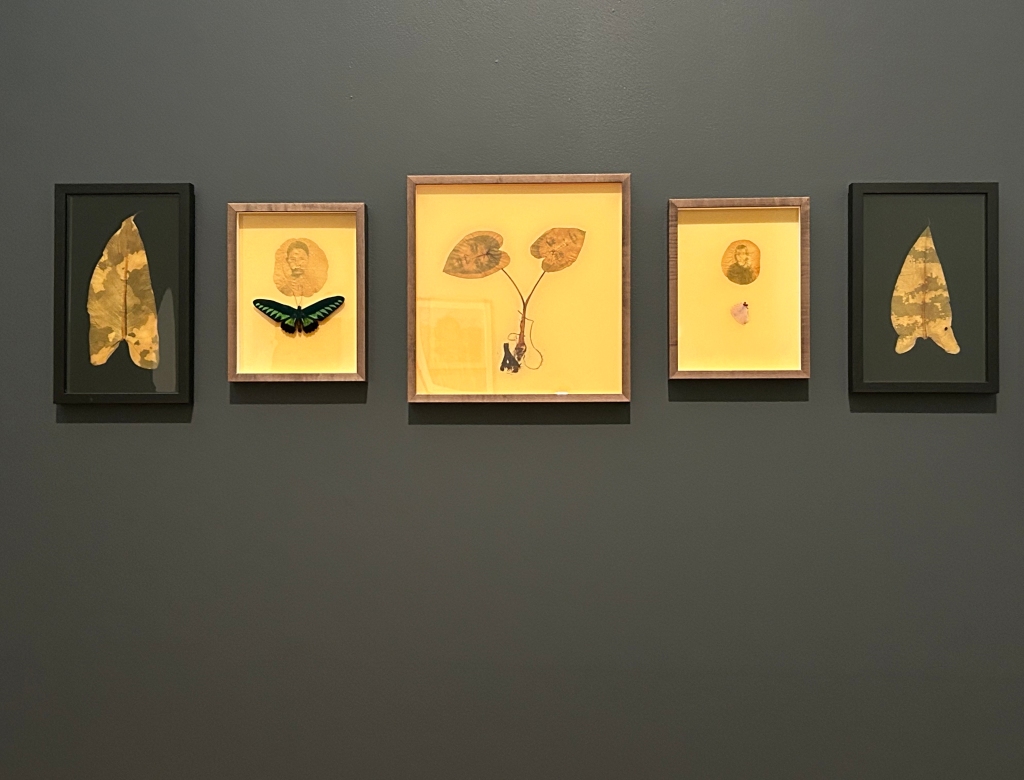Angkor Complex: Cultural Heritage and Post-Genocide Memory in Cambodia
Exhibition Review Part Two
The wooden picture frames also serve as specimen boxes. In each is a bodhi leaf, flattened to a resin plate and preserved there. Their browny-gold surfaces are imprinted with darker pictures of human faces, or the camouflage pattern of army fatigues. The images are created through chlorophyll printing; the photographic picture is developed on fresh green leaves through the action of photosynthesis. It’s a slow process and asks the photographer to wait as the UV rays penetrate through a film negative into the leaf, and the positive image to gradually emerge. Wait too long, and the leaf dries out and crumbles; cut short the process, and the image is muddy.
Pinned under one bodhi leaf portrait is an electric green swordtail butterfly; on another, the broken body and pale pink-blue wings of a much smaller butterfly. They are curious additions. In the colonial era in Cambodia, after the French had forcibly seized the land in the late nineteenth century, such butterflies were collected by entomologist-adventurers, and their Latin names and habitats were noted in micrographic script on tiny pieces of paper that were pinned between the abdomen of the insect and the specimen box. Insects were prized for embodying what was universal about a particular species, rather than for their idiosyncratic morphologies. Here, although that specimen logic surrounding the dead insects lingers, there’s a truth-bearing quality to their uniquely imperfect and unlabelled bodies, amplifying the desire to name the anonymous portrait faces.
So, who are these people? The camouflage patterns suggest that they are victims of war, possibly the US invasions from 1969 to 1973 that forced political changes leading to rise of the Khmer Rouge and the genocide later in the decade.
The next question, then, might be about memory embodied in the images. The bodhi leaves connect them to the Buddha’s first lecture beneath the Bodhi tree, and beyond that, to pan-Asian Buddhist traditions of sacred paintings on bodhi leaves. One such leaf painted by anonymous hands in China depicts arhats (Kalika, Bodhidharma, and Vijaputra, for those who like to be precise) in imperial blue, pastel peach, and lilac pigments on a leaf that looks as if its veins have been traced with gold pigment, as if the living leaf had been transformed into a precious relic.

There is something of that sacredness in the chlorophyll-printed images, where the faces literally grow from the leaf. Although we may never know who they are, their images attune us to how human, butterfly, and bodhi leaf belong to each other in this numinous world, and the fragility of their lives during wartime and colonialism.
Another set of photographs in the exhibition similarly documents the relationship of human to more-than-human in the context of genocide. The images are lush and watery. The photographer Vandy Rattana explains that they are pictures of bomb ponds, craters in chemical-saturated fields created by over two million tons of American bombs. The rice paddy fields, sugar palm groves, and bamboo forests appear to be flourishing, but a closer look reveals the total absence of birds, animals, humans. The photographs manage to convey silence. Curator Nachiket Chanchani rightly calls it a “void” in poisoned life systems.
I ended my previous review of this exhibition (in which I focused on the theme of technologies of violence) with thoughts about Gaza. Here, too, Gaza comes to mind: the total absence of natural life systems in the rubble, the attacks by Israeli settlers on Palestinian farmers and villagers in the occupied West Bank, bombed zoo and annihilation of all living creatures in it. So again, I must ask: Have we learned nothing from the genocide in Cambodia? What does the Angkor Complex exhibition teach us about the interdependence of the human and the more-than-human, and our collective precarity and vulnerability in times of apocalyptic manmade and politically engineered violence?
Installation views:
Left to right:
Binh Dahn, Military Foliage #7 (2010) Chlorophyll print and resin
Binh Dahn, Iridescence of Life #15 (2008) Chlorophyll print, resin, and butterfly specimen
Binh Dahn, Transitional Justice (2008) Chlorophyll print on paper
Binh Dahn, Iridescence of Life #16 (2008) Chlorophyll print, resin, and butterfly specimen
Binh Dahn, Military Foliage #59 (2010) Chlorophyll print and resin
Bodhidharma from series titled Luohans 羅漢圖冊 (17th-18th c) Album of eighteen leaves; ink and colour on bodhi tree leaves. Metropolitan Museum of Art, New York
Installation views:
Vandy Rattana, Bomb Ponds (2009) Set of nine photographs
University of Michigan Museum of Art
Guest Curator: Nachiket Chanchani
On view through July 28, 2024
For the April 4 CNN report (only 2 weeks ago at the time I am writing) about the Biden administration’s recent authorization of the transfer of over 1,000 500-pound bombs and over 1,000 small-diameter bombs to Israel, click here.
Palestine Resources
This list is not exhaustive.
Palestine is a Feminist Issue Pledge (via Palestinian Feminist Collective)
Solidarity With Palestine – A Radical Black Feminist Mandate: A Reading List
Librarians and Archivists with Palestine





